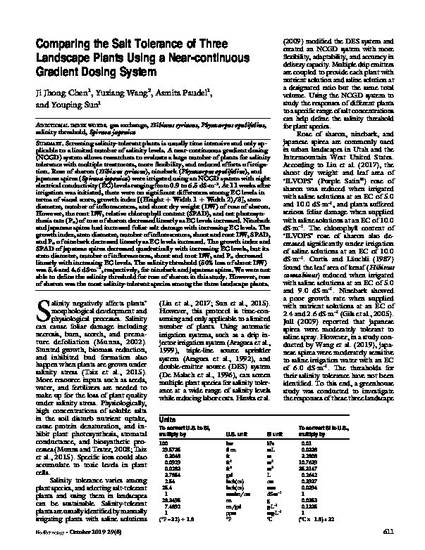
Screening salinity-tolerant plants is usually time intensive and only applicable to a limited number of salinity levels. A near-continuous gradient dosing (NCGD) system allows researchers to evaluate a large number of plants for salinity tolerance with multiple treatments, more flexibility, and reduced efforts of irrigation. Rose of sharon (Hibiscus syriacus), ninebark (Physocarpus opulifolius), and japanese spirea (Spiraea japonica) were irrigated using an NCGD system with eight electrical conductivity (EC) levels ranging from 0.9 to 6.5 dS·m–1. At 11 weeks after irrigation was initiated, there were no significant differences among EC levels in terms of visual score, growth index [(Height + Width 1 + Width 2)/3], stem diameter, number of inflorescences, and shoot dry weight (DW) of rose of sharon. However, the root DW, relative chlorophyll content (SPAD), and net photosynthesis rate (Pn) of rose of sharon decreased linearly as EC levels increased. Ninebark and japanese spirea had increased foliar salt damage with increasing EC levels. The growth index, stem diameter, number of inflorescences, shoot and root DW, SPAD, and Pn of ninebark decreased linearly as EC levels increased. The growth index and SPAD of japanese spirea decreased quadratically with increasing EC levels, but its stem diameter, number of inflorescences, shoot and root DW, and Pn decreased linearly with increasing EC levels. The salinity threshold (50% loss of shoot DW) was 5.4 and 4.6 dS·m–1, respectively, for ninebark and japanese spirea. We were not able to define the salinity threshold for rose of sharon in this study. However, rose of sharon was the most salinity-tolerant species among the three landscape plants.
